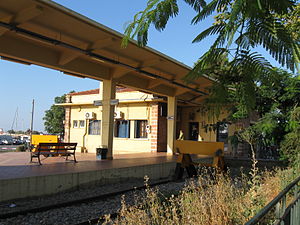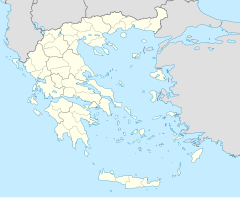Alexandroupolis railway station
Αλεξανδρούπολη Alexandroupolis | |||||||||||||||
|---|---|---|---|---|---|---|---|---|---|---|---|---|---|---|---|
 Alexandroupolis station July 2012 | |||||||||||||||
| General information | |||||||||||||||
| Location | Alexandroupolis Evros Greece | ||||||||||||||
| Coordinates | 40°50′42″N 25°52′45″E / 40.8451°N 25.8793°E | ||||||||||||||
| Owned by | GAIAOSE[1] | ||||||||||||||
| Line(s) | |||||||||||||||
| Platforms | 2 | ||||||||||||||
| Tracks | 3 | ||||||||||||||
| Train operators | Hellenic Train | ||||||||||||||
| Construction | |||||||||||||||
| Structure type | at-grade | ||||||||||||||
| Platform levels | 1 | ||||||||||||||
| Parking | Yes | ||||||||||||||
| Bicycle facilities | Yes | ||||||||||||||
| Accessible | |||||||||||||||
| Other information | |||||||||||||||
| Status | Operational | ||||||||||||||
| Website | http://www.ose.gr/en/ | ||||||||||||||
| History | |||||||||||||||
| Opened | 1874 | ||||||||||||||
| Rebuilt | 1958[3] | ||||||||||||||
| Electrified | No[2] | ||||||||||||||
| Services | |||||||||||||||
| |||||||||||||||
| Former service | |||||||||||||||
| |||||||||||||||
| |||||||||||||||
Alexandroupolis railway station line structure | |||||||||||||||||||||||||||||||||||||||||||||||||||||||||||||||
|---|---|---|---|---|---|---|---|---|---|---|---|---|---|---|---|---|---|---|---|---|---|---|---|---|---|---|---|---|---|---|---|---|---|---|---|---|---|---|---|---|---|---|---|---|---|---|---|---|---|---|---|---|---|---|---|---|---|---|---|---|---|---|---|
| Diagram not to scale | |||||||||||||||||||||||||||||||||||||||||||||||||||||||||||||||
| |||||||||||||||||||||||||||||||||||||||||||||||||||||||||||||||
Alexandroupolis railway station or Alexandroupolid Port railway station (Greek: Σιδηροδρομικός Σταθμός Λιμένα Αλεξανδρούπολης, romanized: Sidirodromikos Stathmos Limena Alexandroupolis) is the main railway station of Alexandroupolis in Eastern Macedonia and Thrace, Greece. Built-in the 1950s to combine the city's then-two stations, the current station is located in the city centre and acts as an interchange for services to Ormenio[4] and Thessaloniki. Trains approaching from Thessaloniki must reverse for a few hundred meters to reach the station.
History
[edit]The central “French” station[5] was opened in 1874, two years after the line from Alexandroupolis (then Dedeagac) to Istanbul via Edirne was completed.[6] Built by the Chemins de fer Orientaux (CO), from Istanbul to Vienna. The railway reached Ftelia in 1873 when the line from Istanbul to Edirne and Bulgaria was opened.[7] When the first station was built, the local rail network was self-contained within the Ottoman Empire.[citation needed] The “Poleos” Station would open later.[8] Until 1909 there was no connection between the lines Istanbul–Alexandroupolis and Thessaloniki–Alexandroupolis (opened in 1896) at Alexandroupolis; a connection existed between Feres and Potamos (near current Avas).[9]
During World War I, the railway was an important link for moving troops and equipment, as the Ottoman Empire, Bulgaria, and Austria-Hungary were all Central Allies. Following the defeat of the Ottoman Empire, its remaining imperial possessions were divided. The sections from Alexandroupolis to Svilengrad, except for a short section of about 10 kilometres (6.2 mi)[10] in Turkey serving Edirne Karaagaç station and for 3 kilometres (1.9 mi) between the Greek border and Svilengrad station in Bulgaria[11] come under the control of the French-Hellenic Railway Company (CFFH), a subsidiary of the CO, when the CFFH was incorporated in July 1929.[citation needed]
Under the Treaty of Lausanne of 1923, a new border between Greece and Turkey was established at the Evros river, just east of Ftelia railway station, which had the result that the railway from Istanbul to Bulgaria entered Greece at Pythion, then re-entered Turkey at Edirne (Karaağaç railway station), re-entered Greece at Marasia, and finally entered Bulgaria between Ormenio and Svilengrad. This arrangement continued until 1971 when two new lines were opened. In Turkey, the Edirne Cut-off was opened to allow trains from Istanbul to Bulgaria to run through Edirne entirely on Turkish territory so that trains such as the Orient Express no longer passed through Ormenio. In Greece, a line was opened to allow trains from Pythion to Bulgaria to stay on Greek territory and avoid Edirne. In 1954 the CFFH was absorbed by the Hellenic State Railways.[citation needed]
29 April 1954 Alexandroupolis Railway Station was the setting for a formal visit by King Paul and then Prince Constantine.[3] In 1958 the station was rebuilt[3] in a more modern style. The following year, the station saw the arrival of German, the Patriarch of Serbia.[citation needed]
In 1971, the Hellenic State Railways was reorganised into the OSE[12] taking over responsibilities for most of Greece's rail infrastructure. In the 1990s, OSE introduced the InterCity service to the Alexandroupolis–Svilengrad line[13] Which reduced travel times across the whole line.[citation needed]
In 2001 the infrastructure element of OSE was created, known as GAIAOSE; it would henceforth be responsible for the maintenance of stations, bridges and other elements of the network, as well as the leasing and the sale of railway assists.[1] In 2005, TrainOSE was created as a brand within OSE to concentrate on rail services and passenger interface. In 2009, with the Greek debt crisis unfolding OSE's Management was forced to reduce services across the network. Timetables were cut back, and routes closed as the government-run entity attempted to reduce overheads. Services from Feres to Alexandroupolis were cut back to three trains a day, reducing the reliability of services and passenger numbers. With passenger footfall in sharp decline. On 11 February 2011, all cross-border routes were closed, and international services (to Istanbul, Sofia, etc.) were ended. Thus, only two routes now connect Alexandroupolis with Thessaloniki and Athens (and those with a connection to Alex / Polis), while route time increased as the network was "upgraded".[14] Services to/from Ormenio were replaced by a bus service. In 2014 TrainOSE replaced services to/from Dikaia with buses[15]
In 2014 TrainOSE replaced services to/from Dikaia with buses[15] In 2017 OSE's passenger transport sector was privatised as TrainOSE, currently a wholly owned subsidiary of Ferrovie dello Stato Italiane[16] infrastructure, including stations remained under the control of OSE. In Late January 2020 a fire "accidentally" started when the possessions of a homeless man (who had found shelter within the courtyard of the station) caught fire for "unknown reason".[17] It was reported that just 20 days later the station was repaired.[17] In July 2022, the station began being served by Hellenic Train, the rebranded TrainOSE.[18]
Following the Tempi crash, Hellenic Train announced rail replacement bus's[19] on certain routes across the Greek rail network, starting Wednesday 15th March 2023.[20]
Facilities
[edit]The station has waiting rooms and a staffed booking office within a 1960s-era building (which was renovated in 2020 following a fire).[17] There are toilets, parking and a Taxi rank also available, as well as bike racks. There is a disabled ramp leading up to the island platform, which is shielded by 1960s-era concrete canopies.
Services
[edit]The station is served by regional stopping services to Dikaia and Ormenio. InterCity trains also serve it to Thessaloniki.
On 30 December 2019, TrainOSE announced re-opening the Alexandroupolis-Ormenio route.[21] As of 2020[update], the Thomas Cook European Timetable notes that the station is served by two daily trains to/from Thessaloniki, and by three pairs of regular trains to Dikaia. However As of 2022[update] it is reported that the timetable was cutback to just two services[22]
There are currently no daytime through trains to/from Athens. International services such as the "Friendship Express" to Istanbul via Pythion remains suspended since 2011.[23][24] Also, there are currently no regular passenger services to Bulgaria.[25]
Between July 2005 and February 2011 the Friendship Express, (an international InterCity train jointly operated by the Turkish State Railways (TCDD) and TrainOSE linking Istanbul's Sirkeci Terminal, Turkey and Thessaloniki, Greece) made scheduled stops at Central Station of Alexandroupolis.[26]
As of October 2024[update] all services are run as a rail-replacement bus service.
Future
[edit]Alexandroupolis railway station and its port could see an upgrade if the plans for the Sea2Sea project go ahead.[27]
Gallery
[edit]-
Diesel Multiple Unit DE-IC 2000N as an InterCity train stands at the Alexandroupolis after arriving from Thessaloniki.
See also
[edit]References
[edit]- ^ a b "Home". gaiaose.com.
- ^ a b c "Annexes". Network Statement (PDF) (2023 ed.). Athens: Hellenic Railways Organization. 17 January 2023. p. 5-6. Archived from the original (PDF) on 24 September 2023. Retrieved 24 September 2023.
- ^ a b c "Την 1η ημέρα ο Θεός έφτιαξε τον Σιδηρόδρομο, την 2η το Λιμάνι: Το παράδειγμα της Αλεξανδρούπολης (ένα άρθρο του κ. Ηλία Σ. Τζιώρα)". Hellenic Train. Retrieved 22 April 2023.
- ^ "» General Network MapOSE". Retrieved 22 April 2023.
- ^ Myrtsidis, Diamantis (2021). Η Ιστορία του Σιδηροδρόμου στον Έβρο (The History of Evros Railway) (in greek) (2 ed.). Nea Vyssa: Myrtsidis. pp. 20–25. ISBN 978-618-00-3174-4.
- ^ Δημήτριος Κίτσος, Ζαφειρία Κοσκίου και Φωτεινή Κυριακοπούλου (ed.). "Αλεξανδρούπολη: Εν αρχή ην … ο σιδηρόδρομος" (PDF). Πρόγραμμα Τοπικής Ιστορίας. 3ο Γυμνάσιο Αλεξ/πολης «Δόμνα Βισβίζη». pp. 34–35. Retrieved 30 March 2016.
- ^ "Trains of Turkey website". Archived from the original on 31 March 2016. Retrieved 3 January 2020.
- ^ "Railway Network: Railway station Alexandroupolis". gaiaose.com.
- ^ Πέτρος Γ. Αλεπάκος. "Η γραμμή του Οθωμανικού Ενωτικού Σιδηροδρόμου Θεσσαλονίκης – Κωνσταντινούπολης (JSC) στο Δεδέαγατς". Πολίτης της Θράκης. 234 (Σεπτέμβριος 2010). Αναδημ. στο alepakos.blogspot.gr. Retrieved 30 March 2016.
- ^ Modern measurement done on www.Openstreetmap.com indicate 10.2 km
- ^ Le Journal des chemins de fer, des mines et des TP, Paris, 29 March 1930 (in French)
- ^ Law 674/1971, Government Gazette A-192/1970
- ^ "Επειδή τα τραίνα είναι γεμάτα ανθρώπους και ιστορίες και όχι μόνο εισιτήρια και αριθμούς…". 18 January 2018.
- ^ "Google Translate". 2 November 2022.
- ^ a b "Κυκλοφοριακές ρυθμίσεις στο τμήμα Αλεξανδρούπολη – Δίκαια από την ΤΡΑΙΝΟΣΕ". Typosthes.gr. Retrieved 22 April 2023.
- ^ "It's a new day for TRAINOSE as FS acquires the entirety of the company's shares". ypodomes.com. Archived from the original on 15 September 2017. Retrieved 14 September 2017.
- ^ a b c "Αλεξανδρούπολη: Αποκαταστάθηκε άμεσα το κτίριο του Σιδηροδρομικού σταθμού, απ' την πυρκαγιά που προκάλεσε καταστροφές". Retrieved 22 April 2023.
- ^ "TrainOSE renamed Hellenic Train, eyes expansion". Kathimerini. Athens. 2 July 2022. Retrieved 14 August 2022.
- ^ GTP editing team. "Hellenic Train Services Replaced by Bus Routes". GTP. Retrieved 10 October 2024.
- ^ athens24, athens24 (14 March 2023). "Hellenic Train announces bus routes instead of trains | Athens24.com". www.athens24.com. athens24.com. Retrieved 10 October 2024.
{{cite news}}: CS1 maint: numeric names: authors list (link) - ^ "Railways in Greece: Poor service, no competition".
- ^ Μυρτσίδης, Διαμαντής (2021). Η Ιστορία του Σιδηροδρόμου στον Έβρο. Νέα Βύσσα: Διαμαντής Μυρτσίδης. pp. 150–152. ISBN 978-618-00-3174-4.
- ^ "2014 Timetable Athens-Thessaloniki-Alexandroupoli-Dikaia" (PDF). Retrieved 22 April 2023.
- ^ "2014/15 Intercity schedule" (PDF). TrainOSE. Retrieved 11 March 2015.
- ^ Myrtsidis, Diamantis (2021). Η Ιστορία του Σιδηροδρόμου στον Έβρο (The History of Evros Railway) (in Greek) (2 ed.). Nea Vyssa: Myrtsidis. pp. 139–152. ISBN 978-618-00-3174-4.
- ^ Myrtsidis, Diamantis (2021). Ιστορία του Σιδηροδρόμου στον Έβρο (The History of Evros Railway) (in greek) (2nd ed.). Nea Vyssa: Myrtsidis. pp. 137–138. ISBN 978-618-00-3174-4.
- ^ "Μιχαηλίδης - Μυτιληνός: Είναι έτοιμη η Αλεξανδρούπολη να υποδεχτεί το Sea2Sea; Στροφή από το λιμάνι στον σιδηρόδρομο".



